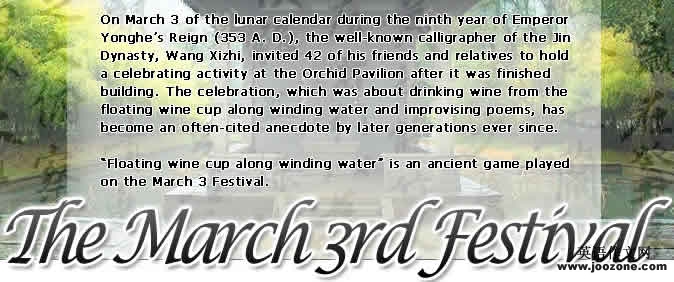liuxuepaper editor note:此文为上巳节及其英文介绍范文,希望对您学习有帮助。
the Shangsi festival
March 3 Festival is also called Shangsi Festival. Shangsi is the first siri of March in the lunar calendar. It was a festival to ward off misfortunes and pray for blessings in ancient China. On that day, the ancients would go to the waterside to play games, take a bath, or pick orchid flowers in the hope of driving away misfortunes and praying for blessings. Called xiuxi, or chunxi, the activity was held early in the Zhou Dynasty. In the Han Dynasty, it was officially prescribed as a festival celebrated on Shangsi of March. liuxuepaper.com
At the Three Kingdoms Period, the festival was stipulated to be held on March 3 of the lunar calendar. Later, the festival was continuously evolved, and the custom of feasting guests on the waterside was formed.
另有上巳节介绍:
Formerly known as "Shangsi Festival", the March 3rd Festival is a traditional festival observed by the Han people and a number of ethnic minority groups. In ancient times, the first Si day (according to the year numbering system by the Heavenly Stems and Earthly Branches) was called "Shangsi" and celebrated as a festival. Most of the time, March 3rd of the lunar calendar happened to be a Si day. So, after the Wei and Jin Dynasties, the Shangsi Festival was set on the third of lunar March and renamed "the March 3rd Festival". Originally March 3rd was more focused on religious activities to ward off disaster and keep evil spirits at bay as well as to pray for having children. The activities included sacrificial rituals in honor of Goddess Gao Mei, "Fu Xi" (a bathing ritual) and get-togethers attended by young men and women etc. liuxuepaper.com
Gao Mei is the Goddess of Marriage and Childbearing. People would pray her for childbearing through sacrificial rituals. Meanwhile, "Fu Xi" was carried out to get rid of ailments by bathing. It was believed to cure women's infertility. And get-togethers through spring outings provided a chance for young men and women to get to know each other and to seek future significant others. Such gatherings were also aimed at marriage and childbearing. In addition, activities like floating eggs, dates and wine cups on the river were also held.

上巳节 shangsi festival
下面是上巳节的一些来历及相关词条:
上巳节
1.The people in ancient time often had a bath in water in the outskirts to remove disaster in the Shangsi festival.
古人在三月的上巳节日里,要在郊外水滨进行沐浴,以达到洗除污垢、除灾去凶的目的,这一习俗被称为"祓禊"。
the folklore of Shang Si
上巳习俗
上巳节中文介绍:
上巳节是中国汉族古老的传统节日,俗称三月三,该节日在汉代以前定为三月上旬的巳日,后来固定在夏历三月初三。“上巳”最早出现在汉初的文献。《周礼》郑玄注:“岁时祓除,如今三月上巳如水上之类”。据记载,春秋时期上巳节已在流行。上巳节是古代举行“祓除畔浴”活动中最重要的节日。《论语》:“暮春者,春服既成,冠者五六人,童子六七人,浴乎七沂,风乎舞雩,咏而归。”就是写的当时的情形。
夏历三月初三为上巳日。古时以夏历三月的第一个巳日称为“上巳”。三月初三多逢巳日。这天,人们把荠菜花铺在灶上以及坐、睡之处,认为可除蚂蚁等虫害;把莽菜花、桐花藏在毛衣、羽衣内,认为衣服可以不蛀;妇女把莽菜花戴在头上,认为可以不犯头痛病,晚上睡得特别香甜。城乡人民还登惠山、鸿山、斗山、西高山踏青。 三月初三为南乡峻嶂山的庙会节场,香船游肪停满烧香滨。婶婶山麓雪浪乡的农民,有快船比赛风俗。上午,各村青年摇着快船,满载村民,赶至辉蹿山看庙会,游节场。午后,快船集中到葛埭桥附近的长广溪参赛,看过迎神赛会和游节场的男女老少也到此观看快船比赛。参赛的快船先作自由表演,各显神通。接着由表演中涌现出来的佼使者自由结合,以两船为一组进行比赛。小组优胜者再自由结合,依次比赛,直至决出冠军为止。比赛时,岸上人声鼎沸,锣鼓喧天;河中船如飞箭,急流勇进,甚为壮观。
上巳节来历
上巳节可推到追念伏羲氏。伏羲和其妹女娲抟土造人,繁衍后代,豫东一带尊称伏羲为“人祖爷”,在淮阳(伏羲建都地)建起太昊陵古庙,由农历二月二到三月三为太昊陵庙会,善男信女,南船北马,都云集陵区,朝拜人祖。农历三月三,还是传说中王母娘娘开蟠桃会的日子。有一首北京竹枝词是这样描述蟠桃宫庙会盛况的:“三月初三春正长,蟠桃宫里看烧香;沿河一带风微起,十丈红尘匝地。”传说西王母原是我国西部一个原始部落的保护神。她有两个法宝:一是吃了可以长生不老的仙丹,二是吃了能延年益寿的仙桃——蟠桃。神话传说中的嫦娥,就是偷吃了丈夫后羿弄来的西王母仙丹后飞上月宫的。此后,在一些志怪小说中,又把西王母说成是福寿之神。
另外三月三除了上巳节外还是西王母生日。此说源于道教传说,每年此日,各路神仙都会赴瑶池献礼祝寿,著名的“麻姑献寿”由此产生。 上巳节还是人日。人日也是传统节日,相传女娲七天之内造出七种动物,按日排列为初一是鸡日、初二是狗日、初三为羊日、初四为猪日、初五为牛日、初六是马日、初七为人日。按子丑寅卯戊己庚辛辛酉戌亥的天干排序和甲乙丙丁辰巳午未壬癸的地支排序法,初七为地支巳日,所以巳日即人日,因此上巳节,也就是人日的节日。纪念人日要吃“七宝羹”和“薰天”。“七宝羹”就是用七种菜做的菜肴,而“薰天”是露天作的煎饼。另外还要用五彩丝织品剪成人形或金箔刻成人形挂在屏风火帐子上,以求吉利。
以上均来自作文地带,希望对您学习有帮助,谢谢。
liuxuepaper.com